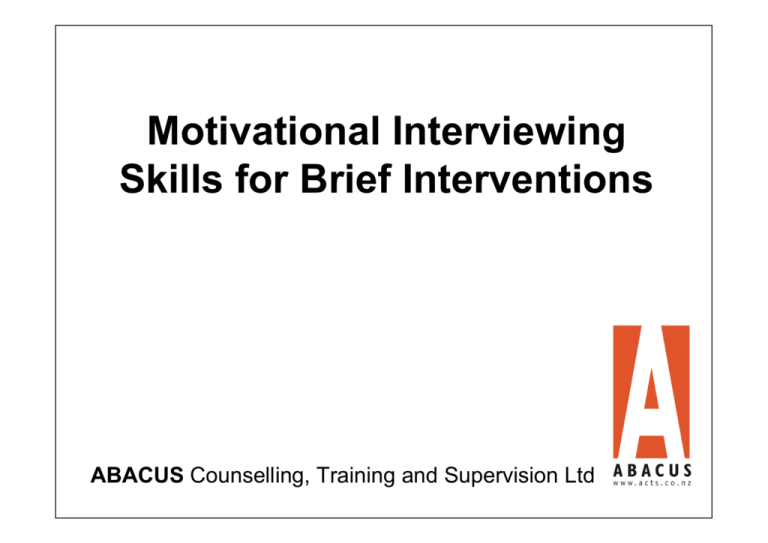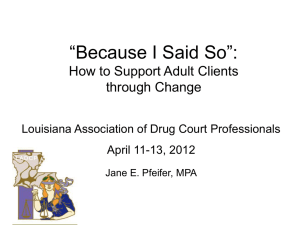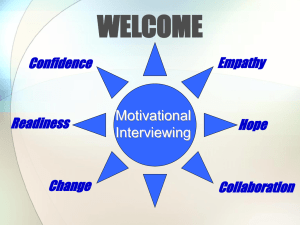View/download - ABACUS Counselling, Training & Supervision
advertisement

Motivational Interviewing Skills for Brief Interventions ABACUS Counselling, Training and Supervision Ltd quiz Telling a person what to do for their own good is most likely to work because people take advice from experts. - false If people won’t take advice the first time, scare them with the consequences. - false Confrontation is a well recognised and successful approach for those with addictions. - false quiz People who are given a choice and select their own response are more likely to follow that direction in changing their behaviour. - true Having empathy with a person is a powerful ingredient in someone’s decision as to whether to take their advice. - true Having a belief in their ability to change is a powerful ingredient in a person making a decision to change their behaviour. - true Gambling Harm “Harm or distress of any kind arising from, or caused or exacerbated by, a person’s gambling, and includes personal, social or economic harm suffered by the person, their spouse, family, whānau and wider community, or in their workplace or society at large” (ref: Practice Requirements Handbook, from Gambling Act, 2003) What are Brief Interventions? • One-on-one interventions in a non-specialist setting, and typically one or two short MI sessions, involving people who do not acknowledge, recognise or accept the harms in their lives from their own or another’s gambling. They have not yet made a commitment to seek support for their gambling (formally or otherwise), or to make necessary changes in their lives. • Sometimes are prompted by education sessions, public health activities (including ethnic-specific groups), or opportunistic health and social service interventions (by suitably trained staff), for example, clients of food banks. • BIs are used not only for a client’s gambling behaviour, but can also be offered to family members and affected others, to help reduce the impacts of another’s gambling and offer support. Trans-theoretical Model of Change Prochaska & DiClemente Transtheoretical Model of Behaviour Change Pre-contemplation Permanent exit Model of change and Interventions • Most brief interventions will take place with people who are at a pre-contemplative or contemplative stage in their thinking about problems related to their gambling, and making changes to their gambling behaviour. • Their focus is upon improving the person’s motivation to change their gambling behaviour • The aim of the brief intervention is to trigger a decision, and a commitment to change, and can include referral to specialist problem gambling intervention services Exercise One: Speaker and Listener • Divide into pairs. • Follow the instructions on your handouts, but don’t share your instructions with your partner. • Speaker starts it off. • Take about 5 minutes for the exercise. • Debrief and feed back to the main group. Brief Interventions and the Model of Change • In the Pre-contemplation stage, using MI skills during a BI can assist in raising awareness of problems, moving the client into Contemplation • In Contemplation stage – using MI skills in a BI can help shift clients towards a decision to change, then into Preparation for positive Action to meet goals Using Motivational Interviewing (MI) in Brief Interventions We will cover: • What is motivation? • What is Motivational Interviewing? • Principles of MI • Strategies and tools of MI • Recognising change talk and resistance • Applying MI skills in Brief Interventions Motivation/Motivational Interviewing “No problem” = no need/no motivation for change Others think it’s a problem and want me to change = external motivation I start to recognise it’s a problem, and think I may need to change = internal motivation Helping practitioner recognises there is a problem; helps me gain insight by eliciting my own concerns, and supports me to change = Motivational Interviewing skills (Miller 2006) Ambivalence • The contemplation stage of change is characterised by ambivalence • “The contemplator’s experience may be described as a kind of seesawing between reasons to change and reasons to stay the same”. • “The counsellor’s task at this stage is to help tip the balance in favour of change”. (Motivational Interviewing - Miller and Rollnick, 1991) Underlying Theory of MI • People are often ambivalent and may have as many reasons against change as for it • If only someone outside themselves wants them to change, then the person may resist it • Continuing resistance can predict lack of change and the client can become “stuck” • When someone is stuck in ambivalence, more pressure to change creates more resistance, and people fight back, to defend their position • Working with people in a way that creates self-awareness, brings out their own internal reasons for change, which helps them become unstuck, and this enhances and supports lasting behaviour change The Heart of MI: • Drawing out (important elements of change are within the client) • Partnership (client as expert; practitioner as resource) • Choice (Only the client can choose to change) Exercise Two: Speaker & Listener • Divide into pairs. • Follow the instructions on your handouts, but don’t share your instructions with your partner. • Speaker starts it off. • Take about 5 minutes for the exercise. • Debrief and feed back to the main group. Principles and Practice of Motivational Interviewing: REDS • Roll with resistance (avoid confrontation, argument, defensiveness – all can provoke resistance). The goal is person’s own solutions: (Internal motivation improves outcomes) • Express empathy (“acceptance” of person) • Develop discrepancy (The difference between where they are now and where they want to be) • Support self-efficacy (Encourage their belief in their own ability to make changes) MI Strategies and Skills: OARS • Open-ended questions (can’t just answer yes or no) help to gather information - note any desire or reasons for change; their own thoughts and concerns • Affirmations to reinforce positive aspects of behaviour and efforts toward change • Reflective listening style • Summarise strategically OARS: Reflective Listening Reflective listening: responding with a statement allows them to agree/disagree and further clarify • Simple: “close” repetition of their words • Complex: (in your words, reflect implicit feelings – more than they said but not more than they meant); matching their emotion: (they feel understood); undershooting (to understate can make them elaborate); overshoot (overstating can make them pull back). Double sided reflection (“on one hand… on the other..”). Start with status quo, end with side favouring change. Forming Reflective Statements • Responding as a statement usually works better than asking questions, because the person doesn’t feel interrogated. (statement requires inflection down, not up, at the end of sentence) • When correct, it encourages the client to agree and elaborate further. Some starters: “So you feel….”; “It sounds like you….”; “You’re wondering if…..”; “You’re concerned that…..” • If you do get it wrong, the client will correct you, and you can take it up from there. Reflective Statements Practice • Form groups: each person in turn completes the words: “one thing about myself that I’d like to change is…” • The rest of the group respond with only reflective listening statements (inflection down - no questions). • Speaker responds with elaboration, starting with (but not limited to) “yes” or “no”. • The next reflective listening statement can then take into account the new information, which adds complexity. Continue until you feel “understood” – go around the group in turn • Feed back small group experience to main group OARS: Summarising Summarising can bring together a client’s previously expressed thoughts, feelings and concerns and shows how they fit together. (select motivational aspects only, that you want them to pick up on). Functions of summaries: • Collecting – gathers and adds momentum • Linking – connects past and present ideas to encourage self-reflection and insight • Transitional – prepares for shifting to new focus • Double sided summary: can be used to highlight discrepancy. An example: “So on one hand there’s these things… and on the other…” Examples of Uses of Summarising: • Collecting: “So you feel that… and also there are other things like…(Question:) What other things..?”; • Linking: “….and I also remember you saying that…” • Transitional: “So, there are a quite a number of things that concern you about this…. Now, we were talking before about…” (Changing subject) • Double-sided: “So even though you have some misgivings about … and feel quite concerned about…, there are some really good things about changing and it sounds quite important to you that you don’t just stay as you are, and do nothing.” Exercise Three: Speaker & Listener • Divide into pairs. • Follow the instructions on your handouts, but don’t share your instructions with your partner. • Speaker starts it off. • Take about 5 minutes for the exercise. • Debrief and feed back to the main group. More MI Strategies and Skills Eliciting “change talk” (self motivational statements): • Elaborate – ask for examples, clarification • Ask to describe typical day, week or time • Look back – life at a time before problems, compared with life now or what they want in future • Look forward – what would you like life to be like in future - what needs to change to get there? • Extremes – worst consequences if no change, or best outcome if changes are made • Goals/values – what’s most important to them – how that fits with what is happening in the present Other Strategies and Skills - Scales Using scales can be a useful way of measuring motivation, feelings, progress, confidence, etc, on a continuum 1 to 10. • Example: “On a scale of 1-10, with one as having no confidence, where would you place yourself as being ready to change?” Client: “About five.” You say: “Five? So, why is that five and not just two?” This gives the client an opportunity to voice some reasons for being half way up the scale and having some confidence (voicing it reinforces that confidence and its rationale). • If they say “two”, You say: “Why is that two and not one?” and/or, “What would need to happen for you to be at six?” Exercise: Scaling Practice • Form into pairs with one leading the exercise and the other as the client. • The client thinks of a typical issue that may come up in regard to something they want to change, or progress, feelings, confidence, etc • The “client” tells it to the other person, who asks a relevant question using a scale format. • The client assigns a number, and the other’s task is to find a way to respond motivationally using the concept shown. • Finally, ask: “So what do you think you’ll do? Dawn – Food Bank Dawn is a 31 year-old newly separated woman with 2 children aged 9 and 7 years. She has come into your service requesting help because she has no money left, has hardly any food in the flat, and she is on her second-to-last cigarette. She has left her violent partner of 6 years, worries he may be tracking her and doesn’t know how she’ll cope. Dawn is a heavy smoker, and is pretty resourceful about keeping up a steady supply, although she never seems to have any money. Dawn has been to the food bank only once before and was managing better then. Dawn is quite talkative and tells you she wouldn’t be here if she hadn’t lost the last of her money on the pokies. She says that last week her strategies worked and she won $150 jackpot, and was able to buy her kids new shoes, bring her rent up to date, and buy several packets of cigarettes. She didn’t think she would need support for very long because she had a lucky feeling about the pokies after payday, and then she would be able to move to another town. Dawn – Role-play • Form into pairs • Pick one person to be “Dawn” • Your task is to do a brief intervention trying out some of the MI skills we have covered: (REDS, OARS, scales, elaborate, typical day, looking back/forward, extremes, goals and values). Next, try offering a “Brief harm Screen” for your client to complete. Reverse roles, then feed back to group. Good Things/Not Good Things Client can discuss positives & negatives of current behaviour and clarify both sides of their ambivalence • When people are stuck/resisting change, they know there are negatives connected with where they are, and usually expect criticism, so are often surprised to be asked first: • List “good/positive things” about current behaviour on left-hand column of the page (use their own words) • List “not so good things” (rather than “bad things” – avoids moral judgements) in the right-hand column. Ask them if it looks correct or ask “How does it look?” There is often a significant visual impact when the right column is longer than the left column. • Useful first summary: “On one hand…(positives); on the other hand…”(not so good things) Decisional Balance (Pros and Cons of Change) Pros of gambling Easier to keep gambling Fills my time Forget problems/stress Pros of stopping Spend more time with family (all happier) Have more money Lift my mood Boost self esteem/pride Cons of gambling Worse quality of life Depressed Don’t like myself/what I do Spend too much money Cons of Stopping Too much time to fill – bored What to do with stress? What would life be like without gambling? Awareness of Stage of Change • Sometimes it is tempting to rush into “action stage”, setting goals and using strategies for change…. • Often the client’s “yes but…” of contemplation, is interpreted as resistance • As you push against resistance, you get reactance (a self perpetuating cycle) and the client can get “stuck” (Motivational Interviewing - Miller and Rollnick, 1991) Awareness of Stage of Change • Resistance is encountered when you use a strategy inappropriate to the stage of change • Decision is an important part of change • Counselling strategies that focus on how to change (action), distract the contemplator client from the crucial issue: commitment to change (decision). (Motivational Interviewing - Miller and Rollnick, 1991) Targeting Strategies to Stages of Change Listening to what others say/how they say it is a good indicator of their stage of change: • Pre-contemplation: “Why? It’s not a problem” • Contemplation: “I like it, but on the other hand…” • Preparation: “I’m going to find out about help” • Action: “I’ve started doing this, next, I will..” • Maintenance: “Things are going to plan” • Relapse: “I went back to using again” Use the strategy that best fits for stage of change Strategies to improve BIs • Check that the person feels “safe” (depression is associated with addictions) – self harm attempts are common – monitor risk • Be aware that the person often wants to continue use, but wishes to stop the problems. It can seem to them that they may have to give up the only enjoyable part of their lives, which is difficult • People are often confused at their difficulties in reducing/stopping use – and for some, at the suddenness and intensity of problems occurring • Be understanding and communicate this – low self esteem also often accompanies addictions Strategies to improve BIs • Acknowledge what stressors may be going on with them/assist them to address it (may be personal, family, financial, or legal issues), in order to connect: those with addictions are often isolated through guilt, secrets and accompanying lies, and put up a front • Goals about their use must be identified by the person themselves – don’t assume it’s always stopping behaviour (they may want to only reduce enough to stop the problems) • Slips are frequent with addictions – discuss them as learning opportunities, before they happen • Avoid any perception of criticism. Encourage honesty and their accepting the consequences of behaviour Strategies to improve BIs When people are “stuck” (eg have trouble changing behaviour), and they feel cornered/have no options, they can react angrily when confronted or judged, and you lose the opportunity to promote positive change: • Don’t get into arguments – or else the person will be defensive and will not be thinking of change • Show empathy for the person’s situation (eg long term use and may have many influences to maintain status quo) • Aim to highlight how continued use can stop them from reaching their goals and cause further problems • Help them to understand that if they are open to it, they can change - belief of possible success is important – small steps can build into big changes Summary • Ambivalence/indecisiveness is normal and under pressure to change, clients can become stuck and resistant – MI helps • REDS- framework for progress (dealing with resistance, developing empathy, enhance motivation by highlighting difference between where they are and want to be, affirming and building on their decisions/efforts to change) • OARS and elaboration/typical day helps to gather more information to strategically reflect on, and put back to the client, to enhance motivation, and clarify their thoughts • Looking backward and forward, extremes, goals and values are useful when applicable, for building motivation Summary • Use of scales is a comparative measure to check aspects of motivation/change • Pros and cons/decisional balance – tools to use to highlight discrepancy and tip the balance toward change • Stage of change is useful for finding out where client is and to target the best response • Stay with the client; if they move back to ambivalence, re-apply the best strategies • MI strategies work with all types of clients, but some will require more time and may need more patience, feedback, affirmations, and summaries. Keep and use all that works! End






